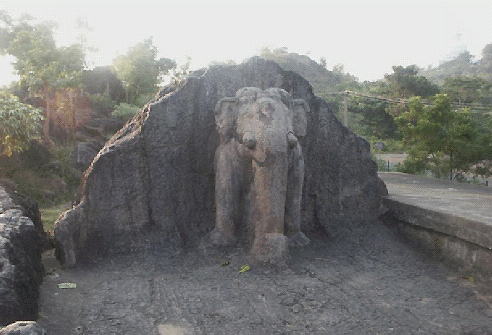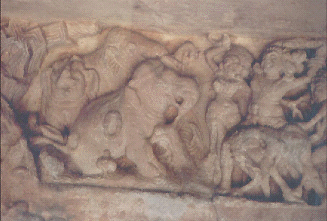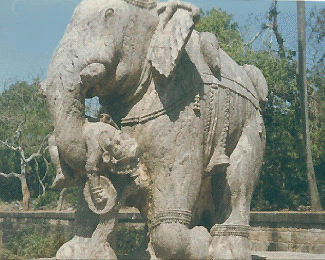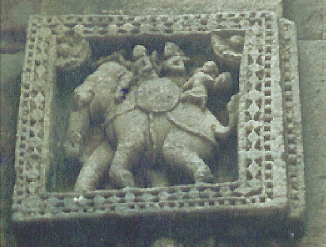Elephants in Art, Architecture and History of Orissa
BY: DEBABRATA SWAIN

Elephant motif half-hewn from a huge stone near Dhauli, Bhubaneswar
The earliest sculpture of Orissa, 3rd century B.C.
Oct 18, SAMBALPUR, ORISSA (SUN) — A two-part exploration of the importance of elephants in Orissan art and religious culture.
Since time immemorial, the elephant has been an integral part of Indian culture and heritage. The Vedic 'King of Gods' (Indra) assumed a distinctly Indian character after localization in the land of the Five Rivers. He ultimately stepped from his chariot, drawn by the steeds of the Aryan horse tamers, and mounted an elephant. Sen (1972) states that it is indeed curious that Indra who was conceived as being borne on a golden chariot drawn by two or many tawny steeds, abandoned his old vehicle and preferred an elephant as his vahana, or carrier.
Craven (1976) observes that hymns in Rigveda, the first and chief book of the Vedas compiled sometime between 1500 and 500 BC, were especially directed towards Indra, the God of the heavens and the warrior King, who rode a white elephant and used the thunder bolt, vajra, as his principal weapon.
INDUS VALLEY CIVILIZATION
The Indus Valley Civilization (c.2500 to 1500 BC), of which impressive remains have been discovered at Mahenjodaro in Sindh and Harappa in Western Punjab (Pakistan), provides one of the earliest picture we have of India's past. Excavations at these places have revolutionised the knowledge of lndia's historical beginnings. A very careful representation of the elephant on seals and on copper plates makes us believe that the living species of the mastodon either attracted the admiration of the people of the valley for its gigantic structure and strength, or where depictions of elephants appear on amulets they were propitiatory in nature (Sen, 1972).
An outstanding icon in Indian art appears in the Harappan culture for the first time on a famous seal from Mahenjodaro. The seal shows a central figure seated on a low throne in a yogic position, appearing along with the elephant, tiger, rhinoceros, buffalo and deer, and two exceedingly stylized human figures (Craven, 1976).
ASHOKA AND THE KALINGA WAR
The history of Indian Art and Architecture is obscure between the Indus Valley period and the 5th century BC, i.e., between the period of Aryan conquest (c. 1500 BC) and the advent of the historical Buddha (c. 566-486 BC). The Greek diplomat Meghasthenes (4th Century BC) has left an account of the architectural design of the city of Pataliputra, the capital of the Mauryan Empire. The architecture of the Ashokan period (c. 273-237 BC) gains in magnificence, as for the first time stone was used instead of wood (Ministry of Information and Broadcasting, 1969).
Little is known of the early part of Ashoka's reign, except that of the eighth year, which was the turning point. In one of his edicts it is said: "Kalinga was conquered by his Sacred and Gracious Majesty when he had been consecrated eight years. One hundred and fifty thousand persons were thence carried away as captive, one hundred thousand were there slain, and many times that number died" (Nehru, 1946).
The horrors of the Kalinga war changed the course of human history and the message of Buddhism reverberated in the ears of the Emperor, who gave up his ambition of Digvijaya in favour of Dharma Vijaya, and became Dharmashoka from Chandashoka.
EARLIEST SCULPTURAL ART OF ORISSA
There is a sculpture of an elephant half-hewn from a huge stone near which Ashoka wrote his Fourteenth Rock Edict at Dhauli, near Bhubaneswar (the present Capital city of Orissa), the site of the great Kalinga War (see image, top of page) . This is one of the earliest specimens of sculptural art in Orissa (4th century B.C). One edict there (3rd century BC) documents not only Ashoka's conversion, but also his missionary zeal for the non-violence of Buddhism. The bell capital discovered at Ashokajhara (Bhubaneswar) has a winged elephant along with other decorative figures on the frieze. Panigrahi (1986) argues the bell capital to be of Ashoka's period (c. 273- 237 BC).
ELEPHANT SYMBOL
There are several descriptions relating to elephants in Indian literature. A popular belief indicating the sign of conception in womanhood by the visit of a snake in her dream (traceable not only in India but also in different parts of the world with slight variations) was directly transferred to the elephant (Zimmer, 1962). Thus, in the Buddhist legend the future Buddha is said to have left Tusita heaven, and was conceived by his mother Maya or Mahamaya in a dream. She saw him descending from the heaven in the form of a white elephant.
Sen (1972) observes that a similar type of legend is also connected with the birth of Mahavira, whose mother, Trisala, is reported to have had a dream of a four-tusked elephant when she conceived the said saviour. But, as the elephant ultimately became the symbol of Buddha who is said to have descended to the earth in the form of an elephanta saddanta according to tradition, it ceased to be a sign of conception for the common woman, although it still remained the symbol of fecundation for the divine female.
The elephant figures at Dhauli and Ashokajhara were intended to remind the people of the birth story of Gautama Buddha. In fact, the great stupa built at Dhauli by Buddhist monks from Japan in the early nineteen seventies depicts on its wall the dream of Mayadevi and the birth of Gautama Buddha.
Thus, the elephant has been represented as raining clouds, the vahana of Indra, fertility of crops, the conception of womanhood, the sign of fecundation of mother goddess and her vahana, the guardian of quarters, the symbol of the Sun and also of the Buddha and Mahavira.
KHANDAGIRI AND UDAYAGIRI CAVES
It is in the caves of Khandagiri and Udayagiri (near Bhubaneswar), that the rock-cut mode found its supreme expression. As known from the Hatigumpha (a cave named after the elephant; Hati elephant and Gumpha = cave) inscription (Udayagiri), most of these caves belong to the 1st century BC and were excavated during the reign of Emperor Kharavela, the greatest ruler of ancient Kalinga.
All the caves, locally called gumphas, were intended as dwelling apartments for Jain monks. In keeping with the rigorous asceticism of the Jain faith, these dwelling cells are quite simple. In some caves the ceiling is so low that one can hardly stand erect and the entrances are so small that one has to crawl to enter the cave. The rear end of the floor inside the cell is slightly raised to serve the purpose of a pillow.
Out of about eighteen excavations in the Udayagiri and fifteen excavations in the Khandagiri, important elephant friezes are seen in Rani Gumpha, Manchapuri Gumpha and Ganesh Gumpha in the Udayagiri series and Ananta Gumpha in the Khandagiri series. The facade of the Rani Gumpha, the most beautiful of the caves, depicts infuriated wild elephants attacking a party of people in a lotus lake. The relief delineates with remarkable success the feelings and action of the panic-stricken group.

Infuriated wild elephants attacking a party of men and women in a lotus lake in Rani gumpha
Udayagiri caves, Bhubaneswar, Orissa, 1st century B.C.
An interesting panel in the Manchapuri cave depicts a royal procession towards an object of worship. The king, as evident from his turreted crown, is on an elephant. He is proceeding with folded hands along with three other persons. Two flying Gandharvas above provide heavenly music and a flying Vidyadhara is seen carrying a tray of flowers in his left hand. It is possible that the scene represents the worship of Kalinga-Jina by Kharavela (Behera. 1991) who, as per the Hatigumpha Inscription, brought back Kalinga- Jina after defeating King Bruhasatimitra of Magadha.
The story of Udayana and Vasandatta is depicted in the Ganesh Gumpha (Plate-3). The artist has chosen the crucial moment of the dramatic flight of King Udayana with princess Vasandatta on an elephant. A party of soldiers is chasing the elephant from behind. On the back of the elephant are three persons of whom one is a woman, perhaps Vasandatta. The central figure is shooting arrows at the soldiers while the figure behind him is throwing coins from a bag to dissuade the soldiers from pursuing. A soldier is seen prostrate on the ground, apparently to collect coins.
The next sequence shows the persons alighting from a kneeling elephant. Thereafter, they are proceeding to the right. Finally, the chief man with folded hands seems to be consoling the woman who is shown in a half-reclining posture. The entrance of the Ganesh Gumpha is flanked by two elephants placed in a later period (Behera, supra).
The Ananta Gumpha, the most beautiful cave of Khandagiri, depicts auspicious motifs such as a four-tusked elephant (Chaturdanta Gaja) and Shri anointed by elephants (Sabhisekha Shri), all related to the dreams of Trisala before giving birth to Mahavira, the famous Jain-Tirthankara (Behera, supra).
All these motifs of elephants carved on the tympana of the caves indicate the possible use of elephants by the royalties in wars, processions etc., and the religious significance attached to the elephant and the elephant symbol. The preponderance of elephant motifs indicates the availability of quite a large number of elephants in the wild as well as in captivity. The sporting of elephants in the lotus lake is indicative of people/elephant conflict that existed even in the 1st century BC of Orissa's history.
MOTIFS IN THE 7TH TO 13TH CENTURY AD
It is difficult to give a coherent history of sculpture after Kharavela, till about the 7th century AD. It seems that during this period, Bhuabaneswar retained its role as an artistic centre. A few railing posts were discovered near the Bhaskareswar temple in Bhubaneswar and are kept in the Orissa State Museum, Bhubaneswar and the Ashutosh Museum, Kolkata. The sculpture on these railings is limited to decorative male or female figures. Between the 7th and 13th centuries AD, innumerable temples were erected in Orissa. The sculptures of the earliest group of extant temples, such as, Satrughneswar, Parsurameswar and Swarnajaleswar, all in Bhubaneswar and the Shiva temple in Badgaon, Ganjam, are quite simple, and being done in low relief seem encrusted on the temple surface.
A few elephant figures depicted on these temples are important from the natural history point of view. An elephant frieze on the relief of the Parsurameswar Temple (650 AD) depicts the catching of an elephant possibly by noosing, and its training. In the 11th century the art of sculpture was highly developed. Some of the finest temple sculptures of Orissa are found in the Rajarani, Brahmeswar and Lingaraj Temples of Bhubaneswar.
Large numbers of elephants are depicted on the walls of these temples, the most important being that of the Lingaraj Temple (c. 1000 AD). The elephant figures commonly denote royal processions, while sculptures of elephants in singles and twos are occasional. In the 12th and 13th centuries, the standard decorative details became magnificently more luxurious, which is evident from an analysis of the details of the temple culture of Bhubaneswar and of the other parts of Orissa state.
The decoration of the outer walls of the Jagannath Temple (12th century AD) of Puri closely follows that of the Lingaraj Temple (Behera, supra). It is also true in the case of elephant motifs on the Jagannath Temple. A series of elephant processions are seen on its outer wall.
KONARKA TEMPLE OF THE 13TH CENTURY AD
It is the sculptures of the 13th century on the Sun temple at Konarka (40 km from Bhubaneswar) on the coast of the Bay of Bengal) that represent the epitome of Orissan sculptural art. The temple is lavishly ornamented from the bottom to the top. Percy Brown (Behera, 1991; 1996) aptly remarked: "Few buildings can boast of such an unrestrained abundance of plastic decoration as this vast structure, every portion of the exterior being moulded and chiselled either in the form of abstract geometrical ornament, conventional foliage, mythical animals, fabulous beings - half human and half serpent coils, figures satanic and figures divine, of every conceivable motif and subject known to the Indian mind and in a technique which ranges from pattern cut with minute precision of cameo to powerfully modelled groups of colossal size".
The richness and exuberance of animal carvings that we notice at Konarka represent an extraordinary achievement. All types of animals have been depicted, both known and unknown e.g., horse, lion, snake, bull, camel, deer, crocodile, monkey, varieties of birds, elephants and their various combinations. Even a giraffe has been shown in the royal courts probably that of King Narasingha Deva I (AD 1238-1264), the builder of this great monument. Though this animal was not known to have existed in India, it might have been imported from Africa, showing the trading links of Orissa far and wide.
However, out of all the animal motifs, that of the elephant requires special mention in this context. Of course, it will not be out of place to mention here that the number of elephants shown on friezes surpasses all other animals. Hence, the elephant motifs both from the religious and artistic point with special reference to its natural history need to be discussed.
The selection of a symbol to represent a particular theme in art depends on the taste and knowledge of the artist and its relevancy to the subject matter (Sen 1972). Of all the implications of the elephant symbol, the animal as the Vahana of Indra took a distinctive role in the religious tales of India and also in art, making its role as carrier of the mother-goddess a secondary one. That is why Sen (supra) states that artists preferred to associate the elephant with the mother goddess, not primarily as her vahana, but as the symbolic source of fecundation by representing two or more elephants flanked on either side of the mother- goddess and bathing her with the waters of life. This is exemplified in the Gajalakshmi motif seen in different temples, the earliest in Orissa being in the Parshurameswar Temple (7th century AD), Bhubaneswar.
But the common Gajalakshmi motif is found to have been altered in a decorative panel of the Sun Temple (13th century AD) at Konarka into that of a sitting female figure with legs wide apart accompanied by an elephant pouring waters of life' into her with its trunk - a highly suggestive symbol of the fecundation of womanhood by an elephant, though a rather unconventional one (Behera, 1996; Sen, 1972). Neither does this woman look like a goddess, nor is the elephant represented equal in size to her.
The Gaja-Simha or the "Lion standing on elephant" motif is another interesting device, which is notably alike for its symbolic significance and imaginative handling. The gigantic pair in front of the Natamandira of the Sun Temple shows this motif at its best. The rampant lion, with open mouth, lolling tongue, flamboyant manes, protruding eyes, stands over the recumbent elephant that in turn keeps a human beneath its trunk. The majesty and vigour of the lion in contrast to the attitude of helplessness of the elephant are well expressed by the sculpture. The motif symbolizes the pious human being fighting for liberation from the bonds of Nature. Such motifs in different forms are common in different temples of Orissa.

Free-standing elephant in the northern courtyard of the Sun temple, Konarka
Orissa, 13th Century A.D.
The great sculptors of Orissa had observed the gait, movements and the anatomical features of animals very minutely and produced innumerable superb animal figures. The free-standing elephants in the northern courtyard of the Sun Temple are distinguished by the dignified bearing and large volume. Elephants appear in a number of situations, e.g., they move in military processions, carry their masters, trot in the jungle, their sexual union, and being driven into the stockade for elephant catching. In all these situations they have been copied from nature.
It is interesting to note here that elephant behaviour was so minutely observed by the artists that in depictions of elephant processions, one can easily mark lefty and righty (like left-handed and right-handed human beings) from the folded movement of the legs.
OTHER TEMPLES OF THE 13TH CENTURY AD
The richness and exuberance of carvings that we notice at Konarka are also seen in other temples of the 13th century, e.g., Dakshaprajapati. The important elephant motif of the Dakshaprajapati Temple of Banapur (Khurda district, Orissa) from the natural history point of view is the exchange of greetings between the members of a pair of elephants.

Warriors on an elephant
Daksha Prajapati Temple, Banapur, Orissa, 13th century AD.
There is the popular Simha-Vyala figure standing over a recumbent elephant. It appears that the artists took fancy in combining features of large cats with other animals (locally called vyala or vidala). Various types of vyalas occur in the jangha of the temples of later periods. The popular devices include Simha-vyala, Gaja-vyala, Aswa-vyala, etc. The Gaja-vyala is an imaginative combination of lion and elephant. The body, tail and paws are of the lion but the face is that of an elephant.
One interesting sculpture, now preserved in the Ashutosh Museum of the Kolkata University and another discovered by Dr. K. C. Panigrahi (Panigrahi, 1986) and now exhibited in the Orissa State Museum, Bhubaneswar, belonging to the medieval temples of Orissa, depicts a series of boats in which elephants are being carried apparently to a distant land. Only a part of this frieze has been preserved. Zigzag lines with half-shown fishes, crabs and crocodiles indicate the waves of the sea.
